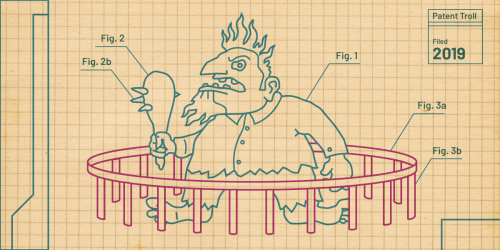Today, the Federal Circuit handed down a 135-page decision in an effort to set the record straight on what can and cannot be patented under § 101 of the Patent Act. Unfortunately, the ten judges could only agree on 55 words:
Upon consideration en banc, a majority of the court affirms the district court’s holding that the asserted method and computer-readable media claims are not directed to eligible subject matter under 35 U.S.C. § 101. An equally divided court affirms the district court’s holding that the asserted system claims are not directed to eligible subject matter under that statute.
Excuse us, what?
First, the good news: the Court agreed to strike down the dangerous patents at issue in the case, CLS Bank v. Alice Corp. These particular patents claimed to cover a computer system used for conducting closing financial transactions by avoiding settlement risk (this is simply the risk that one party cannot uphold its end of the bargain). The lower court found this invention—which "simply provides the formula, or manner, in which to use an electronic intermediary to exchange obligations as a way to hedge against the risk of loss"—abstract and therefore unpatenable. In July 2012, a three-judge panel of the Federal Circuit disagreed and held that implementing this invention on a computer system made it non-abstract and thus patentable.
Happily, today the Federal Circuit reversed itself. In a thoughtful opinion by Judge Lourie, joined by five of the ten judges, the Court invalidated the patents, finding that they contained "nothing ... that represents 'significantly more' than the underlying abstract idea for purposes of § 101." These judges agreed that merely “appending generic computer functionality” to an otherwise abstract concept is not enough to make it patentable–a sensible rule that would likely invalidate many thousands of the vague software patents so beloved by patent trolls.
Kudos to these judges, who also reminded us that the "underlying concern is that patents covering such elemental concepts would reach too far and claim too much, on balance obstructing rather than catalyzing innovation." Of course, this "concern" should be (but unfortunately often is not) the basis of any conversation surrounding patent policy in this country—how to catalyze innovation. Lately, it's been clear that the patent system has failed to accompish this, its fundamental task.
The Court also highlighted the need for "a consistent, cohesive, and accessible approach to the § 101 analysis." We couldn't agree more. The Supreme Court has tried to insert some sanity into the conversation, affirming a basic but sometimes forgotten principle: laws of nature, and obvious methods of working with them, are not patentable. (Importantly, at the same time, the Supreme Court extended its ruling to cover all categories of § 101 ineligible subject matter, signaling that it also thought its ruling should apply to software.) The Supreme Court also called this inquiry a "threshold" one, signaling that parties should be able to make determinations as to whether or not a patent is valid at the outset of a litigation.
Now, the bad news: This decision is an absolute mess. As the Federal Circuit's Chief Judge points out:
No portion of any opinion issued today other than our Per Curiam Judgment garners a majority. The court is evenly split on the patent eligibility of the system claims. Although a majority of the judges on the court agree that the method claims do not recite patent eligible subject matter, no majority of those judges agrees as to the legal rationale for that conclusion. Accordingly, though much is published today discussing the proper approach to the patent eligibility inquiry, nothing said today beyond our judgment has the weight of precedent.
... which means that this ruling essentially fails to give anyone—lower courts, lawyers, inventors, and others facing claims of patent infringement—any real guidance on what is and what isn't patentable, and how to make those determinations in the tough cases.
Finally, the silver lining: This mess of a ruling will help us convince the Supreme Court—as we've tried to do before—that it's time to go back and reconsider patentable subject matter. The high court should clarify its less-than-helpful ruling in Bilski to reinforce that courts and the Patent Office should take § 101 seriously and strike down (or preferably not allow in the first place) the most dangerous and abstract patents.
We're still digesting the Federal Circuit's ruling, which we imagine patent lawyers will be doing for some time. Meanwhile, the world is short four bad patents today, and we hope one step closer to the Supreme Court stepping in and once and for all setting the record straight on dangerous patents that impermissibly tie up abstract ideas.







